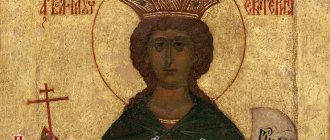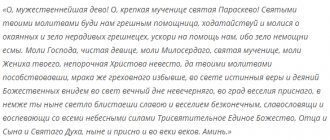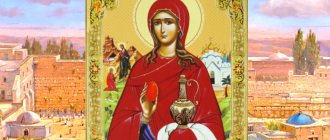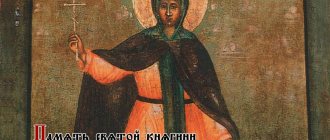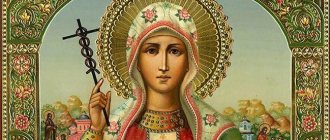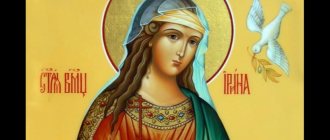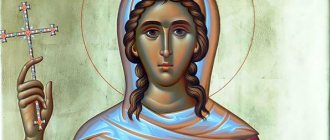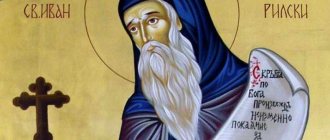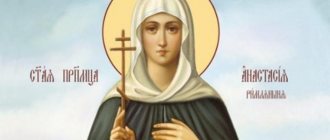Brief biography
Unfortunately, the life story of Sophia of Egypt was lost, and only a few fragments of the chronicle survived. According to church legends, Sophia lived around the 3rd century, when Christians in many countries were subjected to severe persecution. This fate did not escape Sofia. She, along with another martyr Irina, preached on the streets for a long time, bringing the light of truth to the common people of the peasants.
The ruling emperor Aurelian, who hated Christians and worshiped pagan gods, learned about this. Of course, he could not tolerate such obscenities in his lands, ordering the women to be seized and brought before his eyes.
Irina and Sophia were captured by guards and presented to the emperor at the first opportunity. Aureliano decided to win over Christians by promising freedom if they publicly renounce Jesus Christ. The women did not do this, which greatly angered the ruler. He ordered the unfortunates to be tortured and, when the executioners could not achieve the desired result, he executed them both by cutting off their heads. The bodies of the women were buried, and their graves were forgotten for a long time. Only many years later, thanks to the efforts of Constantine the Great, the bodies of the martyrs were transferred to Constantinople, where they found well-deserved peace and respect.
What to see nearby
Nearby, of course, there are a lot of interesting things - the Blue Mosque, the Topkapi Palace, the Archaeological Museum, the Museum of Islamic and Turkish Art, and much more.
But since this text is about the main attraction of Byzantine Orthodoxy, so as not to mix everything together, I will name only a couple of thematic places.
Cathedral of Saint Irene
Leaving Hagia Sophia, take a walk towards the Topkapi Palace, literally in a five-minute walk you will see another cathedral, which was recently opened to visitors.
This is one of the oldest churches in Constantinople - the Cathedral of Hagia Irene, which after the construction of Hagia Sophia was united with it.
Now restoration work is still underway there, and I personally really liked the idea of opening the cathedral-museum to the public at an early stage of its restoration.
Kuchuk Hagia Sophia (Little Hagia Sophia)
I have already written that five years before the construction of Hagia Sophia began, its architects Anthymius and Isidore built the Church of the Great Martyrs Sergius and Bacchus. Justinian loved him very much and invited the same architects to repeat his image on a larger scale, so the similarity of the cathedrals is not surprising.
During the period of Beyazid II, the Ottomans converted the Temple of Sergius and Bacchus into a mosque and gave it the name "Kucuk Hagia Sophia", which means "Little Hagia Sophia".
If you walk from the Hagia Sophia Museum towards the Blue Mosque, then move down towards the sea,
you will end up in a fairly quiet place. Personally, I really like it here.
Go into the yard and get to know its “inhabitants”.
And then go inside.
The mosaics are still covered with plaster, the interior decoration is a bit boring, there is nothing here that will take your breath away.
But I was curious to compare the cathedral with its “younger sister”, and the impressions were quite interesting. Come in and check it out, it won't take too long.
Mosaic Museum
And, if you want to complement the artistic image of ancient Constantinople, go to the Museum of Byzantine mosaics, which is located on the site of the former Great Palace of the Emperors, literally behind the Blue Mosque.
Magnificent Byzantine mosaics were discovered during excavations of the Great Imperial Palace, but that's another story...
Meaning in Orthodoxy
In Orthodoxy, the icon of the Holy Great Martyr Sophia of Egypt is of great importance, which symbolizes:
- constancy of faith even in the face of one’s own death;
- the desire to bring the light of true faith into the hearts of people even in an era of persecution and rejection.
In addition to the personal qualities of the holy great martyr, her name also has significance in religion. Translated from ancient Greek, the name Sophia means the word “Wisdom”. For a long time it was used only by people of noble blood with royal roots. Over time, the name spread throughout the world, and in Russia it changed a little, turning into the commonly used Sofia.
Modern Hagia Sophia - Hagia Sophia - museum
Today there is a huge amount of discussion about the ownership of the cathedral and its return to the Christian world. While the debate is ongoing, Hagia Sophia continues to be a museum of world significance, amazingly combining elements of different eras, worldviews and cultures.
About three million people come here every year.
You can start exploring the museum from the western garden, which contains the remains of columns and other fragments of the first two churches, found during excavations carried out by the Istanbul Institute of Archeology.
Then go inside, examine everything that interests you, and on the way out go to the former baptistery of the cathedral, where the mausoleum of Mustafa I and Ibrahim is now located.
And finally, look at the mausoleum of Sultan Selim II - the work of the genius Mimar Sinan, the mausoleums of Murad III and Mehmed III, which are located in a small separate area to the left of the exit from the baptistery.
These are recommendations from my own experience, obviously you may have your own priorities.
Iconography
The icon of the Holy Great Martyr Sophia of Egypt has several variations of the image, which are united by the following common features:
- the icon depicts a young woman whose head is surrounded by a halo;
- the hair on the head is covered with a white scarf, flowing smoothly onto the shoulders;
- an orange or brown raincoat is thrown over the clothes;
- in Sophia’s hands is the sign of the cross or a scroll with prayers;
Some numbers
Often our impression of visual perception is helped by numbers and facts. Here are some measurements and calculations:
- cathedral area - 7570 sq.m;
- height from floor to top of dome 55.6 m;
- columns: 104 in total, 40 in the lower gallery, 64 in the upper;
- dome diameter: 31.87 meters - from north to south, 30.87 - from east to west;
- number of windows in the dome - 40;
- capacity 100,000 people;
- The diameter of each circle with calligraphic inscriptions is 7.5 meters.
It was in Byzantine times:
- 6000 huge candelabra;
- 6000 portable candlesticks;
- each portable candlestick weighed 45 kg.
What do they ask for and how does the image of a martyr help?
Parishioners who decide to turn to the Lord God through the icon of Sophia of Egypt ask:
- Strengthen your faith. Sophia had a strong and unshakable faith in Jesus Christ and the righteousness of his prayers. All his life he carried the fire of the Christian religion in his heart, continuing to strengthen and support the spirit of parishioners called to heaven.
- Get rid of sinful thoughts. Sofia was a decent woman who avoided any actions that contradicted her faith. If your heart is restless and bad thoughts creep into your head, pray and your soul will find balance and peace.
- About healing from physical illnesses. During her lifetime, the Holy Great Martyr did not possess a strong gift as a healer, but, having elevated her to the rank of saints, she manifests the Will of God by healing the seriously ill.
In addition to the above-mentioned misfortunes, a prayer dedicated to Sophia of Egypt helps to bring peace and tranquility into the house, as well as cope with everyday problems.
Note! Prayer to any saint, regardless of the strength of his character, must come from a pure heart. If this is so, and faith in God is sincere, the sacred image will help with any problem, regardless of its condition.
Image with the Martyr Sophia
There is an icon depicting the martyr Sophia in many churches and home iconostases. Before the image, Christians ask for peace and tranquility in the home, protection from enemies and other misfortunes. Saint Sophia helps mothers in raising their children.
On the icon, Sophia is usually depicted with her children. They stand in front, and behind them in the center is their mother. The main message of the image is that every Christian should remember the value system and cultivate them in his family.
There are many images of Sophia, one of the interesting icons is “Sophia the Wisdom of God”. In this image, the Virgin Mary is shown as wisdom. Here the main thing is not even the person, but the quality, which is personified through the person.
Rules for addressing the icon of the Holy Great Martyr
When referring to the image of the holy great martyr, consider the following nuances:
- before reading the prayer and after its completion, do not forget to shield yourself three times with the banner of the cross;
- you must pray in neat and formal clothing;
- the thoughts of the person praying must be pure and aimed at a good cause. Under no circumstances ask the icon to harm another living being or somehow infringe on its rights. Such a prayer will not find an answer, and negative thoughts can return to you a hundredfold;
- It is advisable to fast before prayer. This way you will properly tune your soul and body.
Ticket prices and how to purchase them
A regular full ticket costs around 12 EUR or 14 USD (40 TL).
There are no benefits for students.
Can go for free:
- Turkish children under 18 years of age;
- children of foreign citizens under 12 years of age;
- citizens of the Republic of Turkey over 65 years of age;
- disabled people and one accompanying person;
- soldiers and sergeants;
- COMOS, UNESCO, ICOM card holders;
- students studying in Turkey on exchange programs (for example, Erasmus) upon presentation of a contract.
You can buy a ticket:
- at the box office, standing in a “live” queue;
- in the machines located at the entrance, opposite the cash desks (the machine does not accept cash, and the card must have a chip - one with a magnetic stripe is not suitable);
- on the museum website (link here).
Entrance to the territory of the burial grounds of the sultans is free.
Prayer text
Oh, long-suffering and wise Great Martyr Sophia of Christ! Stay with your soul in heaven at the Throne of the Lord, on earth, according to the grace given to you, perform various healings: look with mercy at the people who come and pray before your relics, asking for your help: spread your holy prayers for us to the Lord and ask for forgiveness for our sins, healing for the sick, suffering and suffering, first aid: pray to the Lord that He will give us all a Christian goal and a good answer to his Last Judgment, so that it will be given to you and me to glorify the Father, Son and Holy Spirit forever and ever. Amen.
The meaning of the icon “Sophia the Wisdom of God”
In fact, the meaning of this icon is multifaceted and deep; in order to understand exactly the meaning of the icon of Hagia Sophia, some experience of the Orthodox faith and minimal theological education will be required. Such subtleties can be explained by priests or specialized books. Therefore, here it is necessary to say only briefly about the main details:
- Christ appears as wisdom incarnate, He is called the Wisdom of God, which, accordingly, became incarnate through the Mother of God;
- the seven pillars represent the foundations on which the church is based;
- the composition contains the holy apostles (can be in different combinations) and always John the Baptist, who was inextricably linked with Christ.
In general, this composition has an allegorical meaning. Not just gospel figures are depicted here, but each participant in the composition embodies a certain principle. It is useful for the believer to reflect on this image himself during the period of prayer and try to understand the interconnection of the elements.
Celebration days and name days
Name days in Orthodoxy are considered a personal holiday. It is celebrated only by the baptized, and this day falls on the day of honoring the saint in whose honor the second name given at baptism was received. You can choose the name yourself if the person is baptized as an adult, or his parents choose it if he is a child. The name adopted at baptism may differ from the secular one.
Note! It is permissible to take the names only of those people who have been elevated to the rank of saints. If none of the known righteous people is named by the chosen name, it will not be possible to choose him for baptism.
Deeply religious people, familiar with the history of religion and its turning points in history, choose the name of the saint in accordance with their preferences. Ordinary citizens who do not have the necessary knowledge in this area choose one of the following options for the development of events:
- the Orthodox calendar opens and displays the date closest to the birthday on which the celebration in honor of the saint occurs;
- the choice of name is left to the discretion of the priest performing the baptismal ceremony.
Parishioners with the name Sofia can celebrate their name day on one of the following days:
- 28th of February. On this day, services are held in honor of the Venerable Sophia Seliverstova, who was executed during the revolution. For her righteous life, laid down for the good of the church and Jesus Christ, Sophia was elevated to the rank of saints at the beginning of the two thousandth;
- April 1st. April 1 is a holiday in the Orthodox Church, during which panegyrics are performed in honor of Princess Sophia of Slutskaya. She is known as an ardent opponent of the Greek Catholic religion, which opposed such an interpretation of the Laws of God;
- June 4. Day of veneration of the martyr Sophia, about whose deeds little is known. It is believed that he was a skilled doctor and selflessly used his gift in the name of the Almighty. She was tortured for her confession;
- June 17. A holiday in honor of a young Christian woman who lived her life modestly and ascetically. Little is known about his exploits. It is believed that she was a sincere believer and suffered at the hands of atheists, bringing the light of true religion to the masses;
- September 30th. Memorial Day of the most famous of all the great martyrs who bore the name of Sophia. She is considered the mother of three girls named Vera, Nadezhda and Lyubov. Daughters were executed in front of their mothers because the family refused to renounce Jesus Christ. The woman herself died from unbearable pain after burying her children in the cemetery. For the suffering they endured and the firmness of their faith, the women were elevated to the rank of saints;
- October 1st. Day dedicated to Sophia of Egypt. His contribution to the development of religion is difficult to underestimate, especially considering the fact that he had to preach in times of intolerance and persecution by the pagans.
The suffering of the holy martyrs Faith, Nadezhda, Lyubov and their mother Sophia
Holy martyrs Faith, Hope, Love and their mother Sophia
During the reign of Emperor Hadrian, there lived in Rome a widow, originally Italian, named Sophia, which translated means wisdom. She was a Christian, and in accordance with her name, she led her life prudently - according to the wisdom that the Apostle James praises, saying: “the wisdom that comes from above is first pure, then peaceful, modest, obedient, full of mercy and good fruits.” [1] (James 3:17). This wise Sophia, living in an honest marriage, gave birth to three daughters, to whom she gave names corresponding to three Christian virtues: she named the first daughter Faith, the second Hope, and the third Love. And what else could have come from Christian wisdom if not virtues pleasing to God? Soon after the birth of her third daughter, Sofia lost her husband. Remaining a widow, she continued to live piously, pleasing God with prayer, fasting and almsgiving; She raised her daughters as a wise mother could do: she tried to teach them to demonstrate in life those Christian virtues whose names they bore.
As the children grew, their virtues also increased. They already knew the prophetic and apostolic books well, were accustomed to listening to the teachings of their mentors, diligently read, and were diligent in prayer and in household chores. Obeying their holy and wise mother, they succeeded in everything and rose from strength to strength. And since they were extremely beautiful and sensible, everyone soon began to pay attention to them.
The rumor about their wisdom and beauty spread throughout Rome. The governor of the region, Antiochus, also heard about them and wanted to see them. As soon as he saw them, he was immediately convinced that they were Christians; for they did not want to hide their faith in Christ, did not doubt their hope in Him and did not weaken in their love for Him, but openly glorified Christ the Lord before everyone, abhorring the godless pagan idols.
Antiochus informed King Hadrian about all this, and he did not hesitate to immediately send his servants to bring the girls to him. Fulfilling the royal command, the servants went to Sophia’s house and when they came to her, they saw that she was teaching her daughters. The servants announced to her that the king was calling her and his daughters to him. Realizing for what purpose the king was calling them, they all turned to God with the following prayer:
- Almighty God, do with us according to Your holy will; do not leave us, but send us Your holy help, so that our hearts will not be afraid of the proud tormentor, so that we will not be afraid of his terrible torment, and will not be horrified by death; Let nothing separate us from You, our God.
Having said a prayer and bowed to the Lord God, all four - mother and daughters, taking each other by the hands like a woven wreath, went to the king and, often looking at the sky. with heartfelt sighing and secret prayer, they entrusted themselves to the help of the One who commanded us not to fear “those who kill the body but are not able to kill the soul” (Matthew 10:28). When they approached the royal palace, they made the sign of the cross, saying:
- Help us, O God, our Savior, to glorify Your holy Name.
They were led into the palace and presented before the king, who sat proudly on his throne. Seeing the king, they gave him due honor, but stood before him without any fear, without any change in face, with courage in their hearts and looked at everyone with a cheerful gaze, as if they were called to a feast; With such joy they came to the king to be tortured for their Lord.
Seeing their noble, bright and fearless faces, the king began to ask what kind of people they were, what their names were and what their faith was. Being wise, the mother answered so prudently that everyone present, listening to her answers, was amazed at her such intelligence. Having briefly mentioned her origin and name, Sophia began to talk about Christ, Whose origin no one can explain[2], but whose Name every generation should worship[3]. She openly confessed her faith in Jesus Christ, the Son of God, and, calling herself His servant, glorified His Name.
“I am a Christian,” she said, “this is the precious name that I can boast of.”
At the same time, she said that she also betrothed her daughters to Christ, so that they would preserve their incorruptible purity for the incorruptible Bridegroom - the Son of God.
Then the king, seeing such a wise woman before him, but not wanting to enter into a long conversation with her and judge her, postponed this matter until another time. He sent Sophia along with her daughters to a noble woman named Palladium, instructing her to watch them, and three days later to present them to him for trial.
Living in Palladia's house and having a lot of time at her disposal to teach her daughters, Sophia confirmed them in the faith day and night, teaching them with words inspired by God.
“My beloved daughters,” she said, “now is the time of your feat, now the day has come for your disgrace to the immortal Bridegroom, now you, in accordance with your names, must show firm faith, undoubted hope, unfeigned and eternal love.” The hour of your triumph has come, when with the crown of martyrdom you will be married to your most gracious Bridegroom and with great joy you will enter His most radiant chamber. My daughters, for the sake of this honor of Christ, do not spare your young flesh; Do not regret your beauty and youth, for the sake of the Red One, with kindness more than the sons of men, and for the sake of eternal life, do not grieve that you will lose this temporary life. For your heavenly Beloved, Jesus Christ, is eternal health, unspeakable beauty and endless life. And when your bodies are tortured to death for His sake, He will clothe them with incorruption and make your wounds as bright as the stars in the sky. When your beauty is taken from you through torment for Him, He will adorn you with heavenly beauty, which the human eye has never seen. When you lose your temporary life, having laid down your souls for your Lord, He will reward you with endless life, in which He will glorify you forever before His heavenly Father and before His holy angels, and all the heavenly powers will call you brides and confessors of Christ. All the saints will praise you, the wise virgins will rejoice over you and accept you into their fellowship. My dear daughters! do not let yourself be seduced by the charms of the enemy: for, as I think, the king will lavish you with affection and promise great gifts, offering you glory, wealth and honor, all the beauty and sweetness of this corruptible and vain world; but you do not desire anything like this, for all this, like smoke, disappears, like dust is scattered by the wind, and like flowers and grass dries up and turns to earth. Do not be afraid when you see fierce torment, for, having suffered a little, you will defeat the enemy and triumph forever. I believe in my God Jesus Christ, I believe that He will not leave you suffering in His name, for He Himself said: “Shall a woman forget her suckling child, so as not to have compassion on the son of her womb? but even if she forgot, I will not forget you” (Is. 49:15), He will continually be with you in all your torments, looking at your exploits, strengthening your weaknesses and preparing for your reward an imperishable crown. Oh, my beautiful daughters! remember my illnesses at your birth, remember my labors in which I nurtured you, remember my words with which I taught you the fear of God, and comfort your mother in her old age with your kind and courageous confession of faith in Christ. For me there will be triumph and joy, honor and glory among all believers if I am worthy to be called the mother of martyrs, if I see your valiant patience for Christ, firm confession of His Holy Name and death for Him. Then my soul will rejoice, and my spirit will rejoice, and my old age will be refreshed. Then you too will truly be my daughters if, having listened to the instructions of your mother, you will stand for your Lord to the point of blood and die for Him with zeal.
Having listened with tenderness to such instruction from their mother, the girls experienced sweetness in their hearts and rejoiced in spirit, awaiting the time of torment as the wedding hour. For, being holy branches from the holy root, they desired with all their souls what their wise mother Sophia instructed them to do. They took all her words to heart and prepared themselves for the feat of martyrdom, as if they were going to a bright palace, protecting themselves with faith, strengthening themselves with hope, and kindling within themselves the fire of love for the Lord. Encouraging and affirming each other, they promised their mother to actually implement all her soul-helping advice with the help of Christ.
When the third day came, they were brought to the lawless king for judgment. Thinking that they could easily obey his seductive words, the king began to speak to them like this:
- Children! Seeing your beauty and sparing your youth, I advise you, like a father: bow to the gods, the rulers of the universe; and if you listen to me and do what you are commanded, then I will call you my children. I will call the chiefs and rulers and all my advisers, and in their presence I will declare you my daughters, and you will enjoy praise and honor from everyone. And if you do not listen and do not fulfill my command, then you will cause great harm to yourself, and you will upset your mother’s old age, and you yourself will perish at a time when you could have the most fun, living carefree and cheerful. For I will give you over to a cruel death and, having crushed the members of your body, I will throw them to be devoured by dogs, and you will be trampled under foot by everyone. So, for your own good, listen to me: for I love you and not only do not want to destroy your beauty and deprive you of this life, but I would like to become a father for you.
But the holy virgins unanimously and unanimously answered him:
- Our Father is God who lives in heaven. He provides for us and our lives and has mercy on our souls; we want to be loved by Him and want to be called His true children. We worship Him and keep His commandments and commandments, we spit on your gods, and we are not afraid of your threat, for all we desire is to suffer and endure bitter torment for the sake of the sweetest Jesus Christ our God.
Having heard such an answer from them, the king asked mother Sophia what the names of her daughters were and how old they were.
Saint Sophia answered:
— My first daughter’s name is Vera, and she is twelve years old; the second - Nadezhda - is ten years old, and the third - Love, which is only nine years old.
The king was very surprised that at such a young age they had courage and intelligence and could answer him like that. He began again to force each of them to his wickedness and first turned to his elder sister Vera, saying:
- Make a sacrifice to the great goddess Artemis.
But Vera refused. Then the king ordered her to be stripped naked and beaten. The torturers, striking her without any mercy, said:
- Devour to the great goddess Artemis.
But she silently endured the suffering, as if they were hitting not her body, but someone else’s. Having achieved no success, the tormentor ordered her virgin breasts to be cut off. But instead of blood, milk flowed from the wounds. Everyone who looked at Vera’s torment marveled at this miracle and the patience of the martyr. And, shaking their heads, they secretly reproached the king for his madness and cruelty, saying:
“What has this beautiful girl done wrong, and why is she suffering so much?” Oh, woe to the madness of the king and his brutal cruelty, inhumanly destroying not only the elders, but even small children.
After this, an iron grate was brought and placed over high heat. When it became hot like a hot coal and sparks were flying from it, they placed the holy maiden Vera on it. She lay on this grate for two hours and, calling out to her Lord, did not get scorched at all, which led everyone to amazement. Then she was put in a cauldron, standing on a fire and filled with boiling resin and oil, but she remained unharmed in it, and sitting in it, as if in cool water, she sang to God. The torturer, not knowing what else to do with her, how he could turn her away from the faith of Christ, sentenced her to beheading with a sword.
Hearing this sentence, Holy Vera was filled with joy and said to her mother:
“Pray for me, my mother, so that I can finish my procession, reach the desired end, see my beloved Lord and Savior and enjoy the sight of His Divinity.”
And she said to her sisters:
- Remember, my dear sisters, To whom we made a vow, To whom we were carried away; you know that we are sealed with the holy cross of our Lord and must serve Him forever; Therefore we will endure to the end. The same mother gave birth to us, raised and taught us alone, therefore we must accept the same death; as half-sisters, we must have one will. Let me be an example for you, so that you both follow me to our Bridegroom who calls us.
After this, she kissed her mother, then, hugging her sisters, she also kissed them and went under the sword. The mother did not grieve at all for her daughter, for love for God overcame her heartfelt sadness and maternal pity for her children. She only lamented and cared about this, lest any of her daughters be afraid of torment and retreat from her Lord.
And she said to Vera:
“I gave birth to you, my daughter, and because of you I suffered illnesses.” But you reward me for this with goodness, dying for the name of Christ and shedding for Him the very blood that you received in my womb. Go to Him, my beloved, and stained with your blood, as if clothed in purple, appear beautiful before the eyes of your Bridegroom, remember your poor mother before him and pray to Him for your sisters, so that He may strengthen them too in the same patience that you show You.
After this St. Faith was truncated into an honest chapter and went to its Head, Christ God. The mother, hugging her long-suffering body and kissing it, rejoiced and glorified Christ God, who accepted her daughter Vera into His heavenly palace.
Then the wicked king put another sister Nadezhda in front of him and said to her:
- Dear child! Take my advice: I say this, loving you just like your father, bow to the great Artemis, so that you too do not perish, as your elder sister perished. You saw her terrible torment, saw her difficult death, do you really want to suffer the same way? Believe me, my child, that I pity your youth; if you had listened to my orders, I would have declared you my daughter.
Holy Hope answered:
- Tsar! Am I not the sister of the one you killed? Wasn’t I born from the same mother as her? Wasn’t I fed with the same milk and didn’t I receive the same baptism as my holy sister? I grew up with her and from the same books and from the same instructions from my mother I learned to know God and our Lord Jesus Christ, to believe in Him and to worship Him alone. Do not think, king, that I acted and thought differently, and did not want the same thing as my sister Vera; no, I want to follow in her footsteps. Don’t hesitate and don’t try to dissuade me with many words, but it’s better to get down to business and you will see my like-mindedness with my sister.
Hearing this answer, the king handed her over to be tortured.
Having stripped her naked, like Vera, the royal servants beat her for a long time without any pity - until they got tired. But she was silent, as if not feeling any pain at all, and only looked at her mother, blessed Sophia, who stood there, courageously looking at the suffering of her daughter and praying to God that He would grant her strong patience.
By order of the lawless king St. Hope was thrown into the fire and, remaining unharmed like the three youths, glorified God. After this, she was hanged and she was whittled with iron claws: her body fell in pieces and blood flowed in a stream, but a wonderful fragrance emanated from the wounds, and on her face, bright and shining with the grace of the Holy Spirit, there was a smile. St. Nadezhda also shamed the tormentor that he was unable to overcome the patience of such a young girl.
“Christ is my help,” she said, “and not only am I not afraid of torment, but I desire it as the sweetness of heaven: suffering for Christ is so pleasant for me.” For you, tormentor, torment awaits you in fiery Gehenna along with the demons, whom you consider to be gods.
Such speech irritated the tormentor even more, and he ordered the cauldron to be filled with tar and oil, set on fire and the saint thrown into it. But when they wanted to throw the saint into a boiling cauldron, it immediately melted like wax, and the resin and oil spilled and scorched everyone around. So the miraculous power of God did not leave St. Hope.
The proud tormentor, seeing all this, did not want to know the true God, for his heart was darkened by demonic charm and destructive delusion. But, ridiculed by the little girl, he felt great shame. Not wanting to endure such a shame any longer, he finally condemned the saint to be beheaded by the sword. The young woman, hearing about the approach of her death, joyfully approached her mother and said:
- My mother! May peace be with you, be healthy and remember your daughter.
The mother hugged and kissed her, saying:
- My daughter Nadezhda! Blessed are you from the Lord God Most High because you trust in Him and for His sake you do not regret shedding your blood; go to your sister Vera and together with her come to your Beloved.
Nadezhda also kissed her sister Lyubov, who was looking at her torment, and said to her:
“Don’t stay here and you, sister, we will appear together before the Holy Trinity.”
Having said this, she approached the lifeless body of her sister Vera and, lovingly hugging him, out of the inherent nature of human pity, she wanted to cry, but out of love for Christ she changed her tears to joy. After this, bowing his head, St. Hope was cut off by the sword.
Taking her body, the mother glorified God, rejoicing at the courage of her daughters, and encouraged her youngest daughter to the same patience with her sweet words and wise admonitions.
The tormentor called on the third girl, Love, and tried with affection to persuade her, like the first two sisters, to retreat from the Crucified One and bow to Artemis. But the efforts of the seducer were in vain. For who can suffer so firmly for His beloved Lord if not Love, since the Scripture says: “love is strong as death... Great waters cannot extinguish love, and rivers cannot drown it” (Song. 8:6- 7).
The many waters of worldly temptations did not extinguish the fire of love for God in this young woman, nor did the rivers of troubles and suffering drown her; her great love was especially clearly visible from the fact that she was ready to lay down her life for her Beloved, the Lord Jesus Christ, and after all, there is no greater love than to lay down your life for your friends (John 15:13).
The tormentor, seeing that nothing could be done with caresses, decided to give Love over to suffer, thinking with various torments to distract her from love for Christ, but she answered, according to the Apostle:
-Who will separate us from the love of God: sorrow, or distress, or persecution, or famine, or nakedness, or danger, or the sword? (Rom.8:15).
The torturer ordered, stretching her across the wheel, to beat her with a stick. And she was stretched out in such a way that the members of her body were separated from their joints and she, being struck with a stick, became covered with purple blood, with which the earth was watered, as if from rain.
Then the stove was lit. Pointing at her, the torturer said to the saint:
- Girl! just say that the goddess Artemis is great, and I will let you go, and if you don’t say this, then you will immediately burn in this kindled furnace.
But the saint answered:
“Great is my God Jesus Christ, Artemis and you will perish with her!”
The tormentor, enraged by such words, ordered those present to immediately throw her into the oven.
But the saint, without waiting for anyone to throw her into the oven, she herself hastened to enter it and, being unharmed, walked through the middle of it, as if in a cool place, singing and blessing God, and rejoiced.
At the same time, a flame flew out of the oven onto the infidels surrounding the oven, and burned some to ashes, and scorched others and, reaching the king, burned him too, so that he fled far.
In that oven, other faces shining with light were visible, rejoicing along with the martyr. And the name of Christ was exalted, and the wicked were put to shame.
When the stove went out, the martyr, the beautiful bride of Christ, came out of it healthy and cheerful, as if from a palace.
Then the tormentors, by order of the king, drilled her limbs with iron drills, but God strengthened the saint with His help in these torments, so that she did not die from them either.
Who could endure such torment and not die instantly?!
However, the beloved Bridegroom, Jesus Christ, strengthened the saint in order to put the wicked to shame as much as possible, and to give her a greater reward, and so that the mighty power of God would be glorified in the weak vessel of man.
The tormentor, sick from the burn, finally ordered to behead the saint with a sword.
She, hearing about this, rejoiced and said:
“Lord Jesus Christ, who loved Thy servant Love, I sing and bless Thy much-sung name for the fact that Thou hast punished me together with the sisters, making me worthy to endure for Thy name the same thing that they endured.”
Her mother St. Sophia, without ceasing, prayed to God for her youngest daughter, that He would grant her patience to the end and told her:
“My third branch, my beloved child, strive to the end.” You are walking the good path and a crown has already been woven for you and the prepared palace has opened, the Bridegroom is already waiting for you, looking from above at your feat, so that when you bow your head under the sword, he will take your pure and immaculate soul into his arms and rest you in peace. your sisters. Remember me, your mother, in the kingdom of your Bridegroom, so that he will show mercy to me and not deprive me of participating and being with you in His holy glory.
And immediately St. Love was cut off by the sword.
The mother, having accepted her body, placed it in an expensive coffin along with the bodies of saints Faith and Hope and, having decorated their bodies as it should, placed the coffin on a funeral chariot, drove them out of the city some distance and buried her daughters with honor on a high hill, crying from joy. While at their grave for three days, she fervently prayed to God and herself rested in the Lord. Believers buried her there along with her daughters. Thus, she did not lose her participation with them in the Kingdom of Heaven and the martyrdom, because if not with her body, then with her heart, she suffered for Christ.
Thus, the wise Sophia ended her life wisely, bringing her three virtuous daughters Faith, Hope and Love as a Gift to the Holy Trinity.
Oh, holy and righteous Sophia! What woman was saved through childbearing[4] like you, who gave birth to such children who were ignorant of the Savior and, having suffered for Him, now reign with Him and are glorified? Truly you are a mother worthy of wonder and good memory; since, looking at the terrible, severe torment and death of your beloved children, you not only did not grieve, as is typical for a mother, but, consoled by the grace of God, you rejoiced more, you yourself taught and begged your daughters not to regret this temporary life and to shed their blood without mercy for Christ the Lord.
Now enjoying the vision of His most radiant face together with your holy daughters, send wisdom to us, so that we, preserving the virtues of faith, hope and love, may be worthy to stand before the Most Holy, Uncreated and Life-Giving Trinity and glorify Her forever and ever. Amen.
Kontakion, tone 1:
Sophia's honorable most sacred branches, Faith, and Hope, and Love, appearing, filled the wisdom with Hellenic [5] grace: both the sufferer and the victorious woman appeared, tied with an incorruptible crown from all the Lords.
Torment of girls
At that time, the eldest Vera was only twelve years old, Nadezhda was two years younger than her sister. And the youngest Lyubov was very small, she was nine years old.
But, despite such a young age, the sisters turned out to be wiser and braver than some adults. They knew what awaited them if they confessed their faith, but they stood firm in their position.
The angry emperor decided to start torturing his elder sister. The other girls and mother stood right there and watched her suffering. He hoped that under the impression they would become frightened and renounce their faith. But he was wrong.
Faith
They began to beat Vera mercilessly with metal bars, so that her flesh fell in pieces to the ground. Then they put her on a hot grate and burned her wounds. Then they threw it into a boiling cauldron. All this torment could not force the young Christian to renounce her faith. Then they cut off her breasts, milk gushed out of them instead of blood.
Seeing that the torment did not bring the desired result, the emperor ordered her head to be cut off. Faith said she would gladly die for her Savior. The mother, seeing her daughter’s torment, not only did not lose heart, she was happy for her and persuaded the other daughters to imitate her and gain strength in spirit. “Just a little and you will find yourself close to Our Lord .
Hope
After killing Vera, the tormentor called for his middle sister. Nadezhda boldly and joyfully entered the threshold of torment. Just like her sister, she refused to sacrifice to idols, and they began to torture her. She was also beaten with sticks and thrown into a burning cauldron, but she did not utter a word. Then she too was beheaded.
Love
It's little Lyubov's turn. Her mother, as best she could, strengthened her with words, persuading her to look at the bodies of the tortured sisters, that they were already enjoying in heaven. The cruel torturer subjected the girl to even greater torture. Her body was tied to a wheel and beaten with sticks. The ground quickly turned red with blood. But the little martyr was silent. Then they threw her into a burning oven, but the fire did not harm her, and the flames, bursting out, scorched her tormentors. After this, the girl's head was cut off.
What to give Sofia for Angel's Day
On the day when the day of the angel Sophia is celebrated, it is recommended to visit church, confess and receive communion. Name days, as a rule, pass quietly, without large feasts. The holiday should be conducive to spiritual conversations.
As for the gift for the birthday girl, it should not be the same as that given for a birthday. After all, this is, first of all, a religious holiday. The gift should emphasize religiosity and Christian traditions.
This could be, for example, a small piece of jewelry - an icon with the image of St. Sophia. In the future, it can be passed on from generation to generation. Thus, the icon will become the property of the family and preserve the memory of their ancestors.
